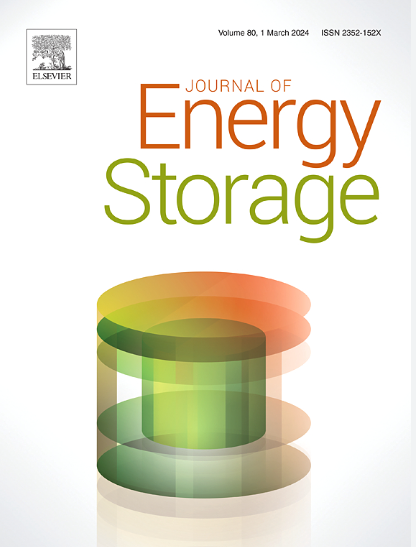Enhanced pseudocapacitor performance using polyaniline‑zirconium dioxide nanocomposite all-in-one hydrogel
IF 8.9
2区 工程技术
Q1 ENERGY & FUELS
引用次数: 0
Abstract
Hydrogel electrolytes play a distinct and vital role in the development of flexible supercapacitors, as they facilitate excellent interfacial contact with the electrodes. Nevertheless, there remains a substantial opportunity for further development in supercapacitor design, particularly when employing binder-type electrode materials. This is due to the presence of interfacial contact resistance, which can compromise the supercapacitor's performance. Additionally, there are instances where the electrode materials fail to adhere completely to the electrode substrate, leading to a decline in the electrochemical performance of the supercapacitor. To address these challenges, a self-healing, all-in-one hydrogel supercapacitor was fabricated via in-situ polymerization of aniline and Zirconium dioxide (ZrO2) nanocomposites on the surface of self-healing natural rubber-based hydrogel electrolyte. This study introduces ZrO2 nanoparticles along with polyaniline to enhance the all-in-one supercapacitor's performance, leveraging their exceptional structural, thermal, and electrochemical properties. When subjected to galvanostatic charge-discharge tests, the flexible all-in-one hydrogel supercapacitor displayed impressive areal capacitances, reaching 36.59 mF/cm2, 42.59 mF/cm2, and 47.62 mF/cm2 for PZ0, PZ1, and PZ3 respectively, at a current density of 0.5 mA/cm2. Notably, the highest energy density and power density were achieved by PZ3 (containing 0.3 wt% ZrO2), yielding 144.67 μWh/cm2 (at 0.5 mA/cm2) and 1345.10 μW/cm2 (at 1 mA/cm2), respectively. Even at higher current densities (1 mA/cm2), the all-in-one hydrogel supercapacitor retained 61.84 % of its initial capacitance. These remarkable electrochemical properties of PZ3 are attributed to the ZrO2 incorporation, by promoting Faradaic reactions at the electrode.

利用聚苯胺-二氧化锆纳米复合一体水凝胶增强假电容器性能
水凝胶电解质在柔性超级电容器的发展中发挥着独特而重要的作用,因为它们促进了与电极的良好界面接触。尽管如此,超级电容器的设计仍有很大的发展空间,特别是在使用粘合剂型电极材料时。这是由于界面接触电阻的存在,这可能会损害超级电容器的性能。此外,在某些情况下,电极材料不能完全粘附到电极衬底上,导致超级电容器的电化学性能下降。为了解决这些问题,在具有自修复能力的天然橡胶基水凝胶电解质表面,通过原位聚合苯胺和二氧化锆(ZrO2)纳米复合材料,制备了一种具有自修复功能的一体化水凝胶超级电容器。本研究将ZrO2纳米颗粒与聚苯胺一起引入,利用其特殊的结构、热学和电化学性能来增强一体化超级电容器的性能。当进行恒流充放电测试时,柔性一体化水凝胶超级电容器显示出令人印象深刻的面电容,在0.5 mA/cm2的电流密度下,PZ0、PZ1和PZ3的面电容分别达到36.59 mF/cm2、42.59 mF/cm2和47.62 mF/cm2。值得注意的是,PZ3(含0.3 wt% ZrO2)的能量密度和功率密度最高,分别为144.67 μWh/cm2 (0.5 mA/cm2)和1345.10 μW/cm2 (1 mA/cm2)。即使在较高的电流密度下(1ma /cm2),一体化水凝胶超级电容器仍保持其初始电容的61.84%。PZ3具有这些显著的电化学性能是由于ZrO2的加入促进了电极上的法拉第反应。
本文章由计算机程序翻译,如有差异,请以英文原文为准。
求助全文
约1分钟内获得全文
求助全文
来源期刊

Journal of energy storage
Energy-Renewable Energy, Sustainability and the Environment
CiteScore
11.80
自引率
24.50%
发文量
2262
审稿时长
69 days
期刊介绍:
Journal of energy storage focusses on all aspects of energy storage, in particular systems integration, electric grid integration, modelling and analysis, novel energy storage technologies, sizing and management strategies, business models for operation of storage systems and energy storage developments worldwide.
 求助内容:
求助内容: 应助结果提醒方式:
应助结果提醒方式:


